Vanilla is such a popular and beloved ingredient that’s used in so many of our baked goods. Imagine a world without vanilla flavored custard, creams, puddings, sauces, cookies, or cakes.
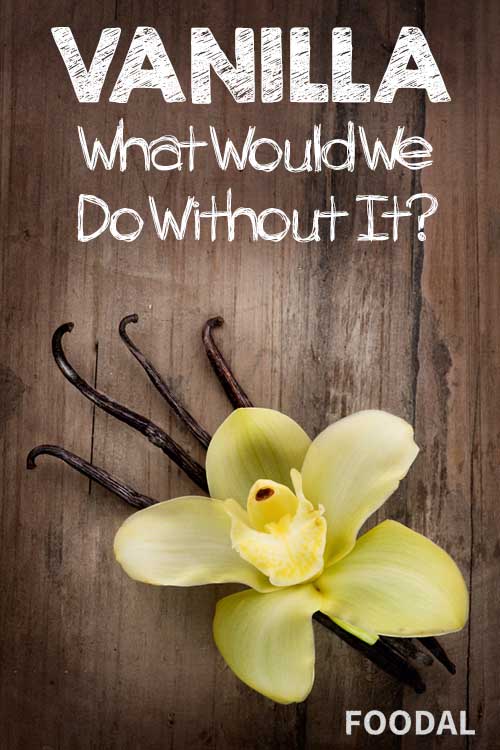
The highly aromatic, warm and sweet flavor is comforting and uplifting. It suits every season, and it suits so many different recipes.
Besides sweets, vanilla is delicious in savory applications as well, like vegetable, fish and poultry dishes. You can add it to your salad dressings, dips or sauces too, for a tasty twist that’s just a touch extravagant.
Let me introduce you to the world that’s inhabited by the queen of spices. I’ll tell you all about its production, origins, and the many different types of vanilla products, like the beans, sugar, extracts or paste. Finally, we’ll wrap up with a tasty recipe that features that essence of vanilla.
Where does vanilla grow?
Let’s start at the beginning. Vanilla finds its origins in Mexico.
Long before the Spanish conquerors brought the spice to Europe in the sixteenth century, the Aztecs were already using it to flavor their famous chocolate drinks. Alongside cocoa, it became a precious and beloved spice enjoyed by European royalty.
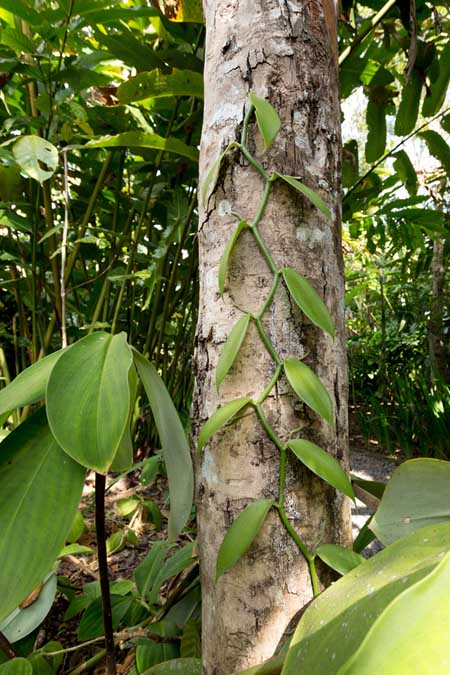
Today, the main area of cultivation for real vanilla is Madagascar, followed by the Comoros and La Réunion, a former colony of France. In earlier times, the isle was called Bourbon, which is where the famous bourbon vanilla gets its name from.
Additional growing regions include Java in Indonesia (a former Dutch colony) and Tahiti. Some vanilla is still produced in Mexico nowadays as well, though production there is far exceeded by that of other regions.
Each regional variety of vanilla features particular characteristics.
For example, the Indonesian variety is mainly used in cosmetics or liquors, while Tahitian vanilla has a stronger floral scent, making it a popular ingredient for use in fragrances.
The Bourbon and Madagascan strains are the two most common sorts when it comes to baking and cooking.
It all starts here: the orchid
Vanilla production takes an enormous amount of time and patience. The “beans” or pods are the actual seed capsules of an exotic species of a tree-climbing orchid.

Before the beans achieve their familiar black and wrinkled appearance, they must first pass through a long process of growth, pollination, and fermentation.
It takes four years for the orchid to bear its first fruit. Shortly before the blooming period (which is limited to mid-morning for just a few weeks) the green, unripe pods are picked.
This happens approximately months after pollination. And it doesn’t take place naturally – the fruits have to be pollinated by hand.

The process of drying and fermentation that follows can take up to several weeks. During this time, the pods shrink and take on the blackish-brown color that we are familiar with.
Tiny crystals also develop on the surface of the pods. These are a sign of quality – try to pick them out the next time you’re buying vanilla beans.
Vanillin is the main flavor that develops during fermentation. It is the spice’s strongest flavoring agent. Today vanillin is also produced synthetically, however, the authentic, natural substance is in no way comparable to the artificial one.

Inside the now shrunken and wrinkled pod, you will find the seeds and some oily liquid, both of which combine to form the vanilla pulp.
The invention of synthetic
It’s because of this tedious production process that real vanilla is one the most expensive spices, besides saffron and cinnamon.
Back in the nineteenth century, the chemist Wilhelm Haarmann successfully produced the flavoring agent synthetically, and artificial vanillin was born.
The invention of imitation vanilla had a powerful effect on authentic production of the spice.
The artificial extraction made it a lot easier and, of course, cheaper for the industry to produce the required flavor. Today, more than 90% of the world’s demand for vanilla is met by the imitation variety.
Even so, the artificial flavoring can’t truly replace the authentic one, since vanillin is only one of several hundred natural flavoring agents that combine to create the complex aroma of the real spice.
Take a look at the ingredients list on your favorite products to find out whether your yogurt or ice cream is made with real vanilla, or artificial vanillin.
Tiny black specks will reveal this secret, too. A pure white appearance in vanilla-flavored baked goods and other products is a clear sign of artificial flavoring (but not the only sign – some manufacturers actually add black flecks to their products to further imitate the real thing).
How to use the beans
Using it straight from the pod is the purest way to flavor whatever you are making with vanilla.
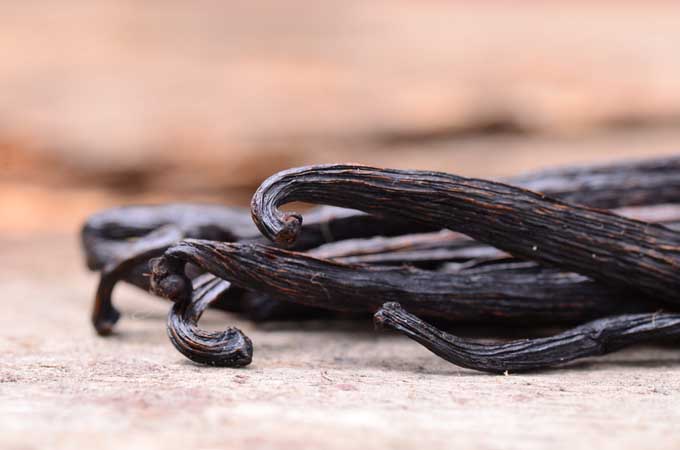
If you don’t want them to lose their aroma, keep the pods in an airtight jar at room temperature, stored in a cool place away from sunlight.
High-quality pods should have a blackish-brown color with a shiny surface that may be covered with tiny crystals. They should feel leathery, but they should also be flexible.
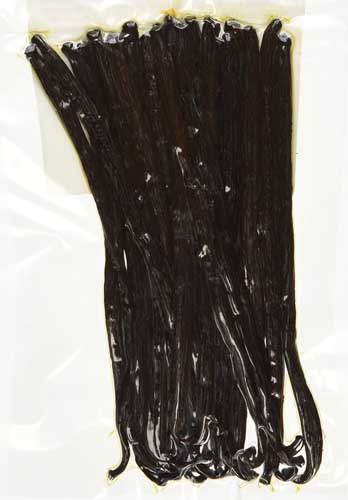
Madagascar Bourbon Planifolia Grade A Gourmet Vanilla Beans available on Amazon
Often, they are sold in small glass tubes. This packaging is suitable because the pods tend to absorb odors from other products, and they will quickly lose their aroma when exposed to the air.
To get at the pulp, cut the pod lengthwise and scrape it out with a blunt knife or a small spoon.
The pulp itself is the oily liquid found inside the beans, while the small dots you see are actually the seeds. Both hold the main flavoring agents of the fruit.
It would be such a waste to only use the pulp that’s inside and throw away the pods. Instead, it’s easy to make your own naturally flavored cooking liquids, sugar or salt.
After you’ve scraped out the pulp, you can reuse the pod in a variety of ways:
- If your recipe requires boiling a liquid like milk, place it in the pot as well, to add some flavor (great for porridges and hot cereals) – pull it out before you add your grains.
- Rinse the pod and let it air dry to be used once or even twice more – there is enough flavor inside to scent a few batches of cereal.
- Place it in a jar filled with granulated sugar. It will take some time for the pod to release its full aroma, but the wait is worth it. Shake the jar from time to time to spread the flavor. This works with salt as well!
Other varieties
For the whole range of vanilla products, one simple rule applies:
Take a close look at the ingredients to make sure they contain the real spice on its own, or with only a few extra ingredients.
Vanilla sugar
Flavored sugar is handy to have, and it can be added to tea, or used with common sugar in baking. Be sure to buy a version that is not made with vanillin. The cheaper mixes often have a shiny, pure white color without any seeds.
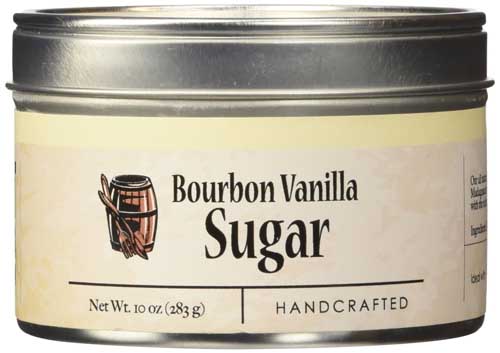
Foodal recommends Bourbon Vanilla Sugar available on Amazon
The best and most convenient choice is:
Simply make your own! Especially if you already cook with vanilla beans, following the tips outlined above to make homemade sugar will save you some money.
Vanilla bean powder
The powder consists of shredded and ground pods. This is a good alternative if you don’t have any pods on hand, and would like to flavor your dishes altering their appearance by adding those black flecks.
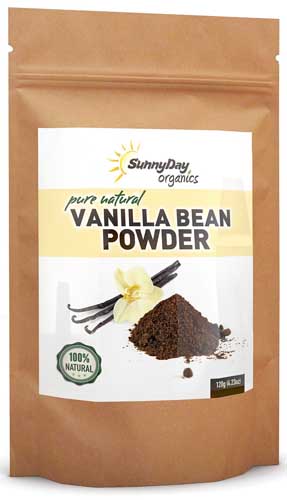
Foodal recommends SunnyDay Organically Grown Vanilla Bean Powder available on Amazon
Vanilla bean paste
Few ingredients are added when the spice is made into a paste. Often, these include just sugar and water. Sometimes, a natural thickener is added to provide a smooth and rich texture. Still, keep an eye out for any artificial flavoring agents.
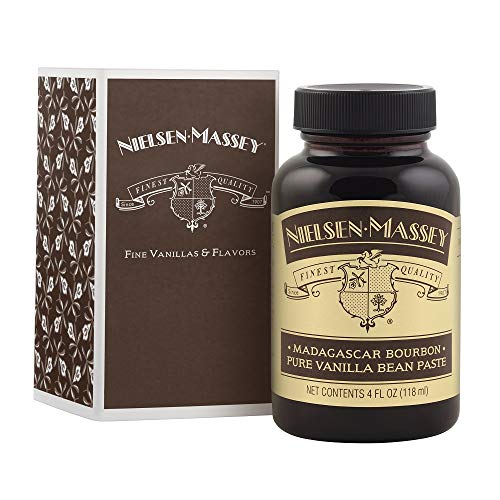
Nielsen-Massey 4-oz. Madagascar Bourbon Pure Vanilla Bean Paste
Whether you choose to use powder, paste or extract depends on your personal preference. However, some recipes do require a certain product.
Plus, paste and extract are often highly concentrated, and must be added in small doses.
Vanilla extract
Liquid extract is easy to measure. It’s also the most economical option, since you often need only a few drops to flavor a recipe. It’s perfect for use in smoothies, shakes or hot chocolate.
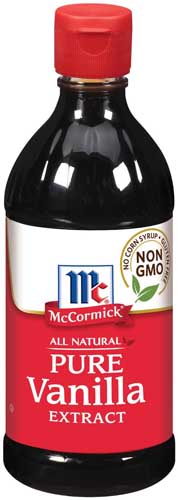
McCormick Pure Vanilla Extract, 16 fl. oz., available on Amazon
What you need to consider is the fact that the flavor of the beans is extracted in alcohol. On the other hand, this is also what makes the extract a long-lasting product.
If you’d like to have another variety for your cabinet, try my recipe for homemade flavored syrup. It’s easy to prepare and it makes a great addition to drinks, desserts and homemade ice cream.
Homemade Vanilla Syrup
You’re probably familiar with lots of syrups with caramel, chocolate or nut flavors.

Syrup is a great choice if you want to add just a little hint of flavor to your coffee drink or cocktail. Since it’s made of sugar, you usually won’t need any extra sweeteners when you add it to recipes.
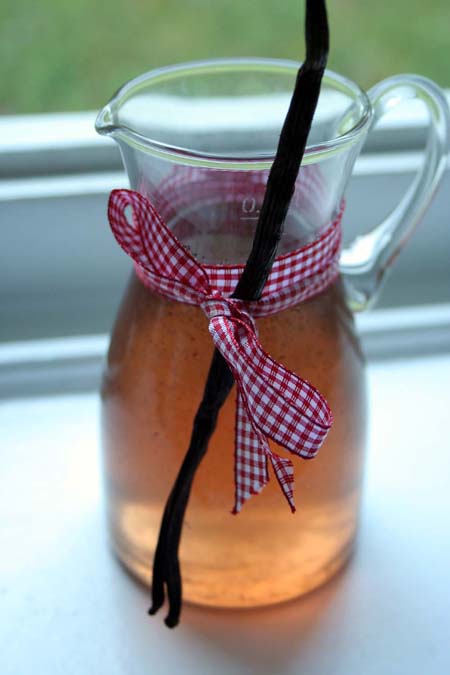
Whereas cheap mass-produced products are often made with artificial ingredients, this homemade version provides you with the real flavor experience. Plus, it makes an amazing gift for vanilla fans, too.
In the end, the syrup will contain the tiny black seeds, too. If you want to, pour it through a fine sieve and filter them out for a clear syrup.
- 1 vanilla bean
- 9 oz water (about 1 cup + 2 Tbsp)
- 9 oz granulated Sugar (about 1 cup + 3 Tbsp)
- Cut the vanilla bean lengthwise and scrape out the pulp.
- Add both to a saucepan along with the water and sugar. Bring to a boil, stirring constantly. The sugar needs to dissolve completely.
- Reduce heat to low and simmer for 10-15 minutes, depending on your preferred consistency. Tip: The longer you leave it on the stove, the thicker it will get when completely cooled.
- Once cooled, pour into decorative bottles or jars and seal. Consume within a couple of weeks.
What’s your favorite choice when you cook or bake with vanilla?
Have you tried using it to flavor savory dishes, too?
Share your thoughts and experiences in the comments and don’t forget to check out Foodal’s Ultimate Guide to Kitchen Herbs and Spices!
Vanilla Syrup photos by Nina-Kristin Isensee, © Ask the Experts, LLC. ALL RIGHTS RESERVED. See our TOS for more details. Uncredited photos: Shutterstock, Vanilla Products USA, Bourbon Barrel Foods, SunnyDay Organics, Nielsen-Massey, and McCormick.
About Nina-Kristin Isensee
Nina lives in Iserlohn, Germany and holds an MA in Art History (Medieval and Renaissance Studies). She is currently working as a freelance writer in various fields. She enjoys travel, photography, cooking, and baking. Nina tries to cook from scratch every day when she has the time and enjoys trying out new spices and ingredients, as well as surprising her family with new cake creations.


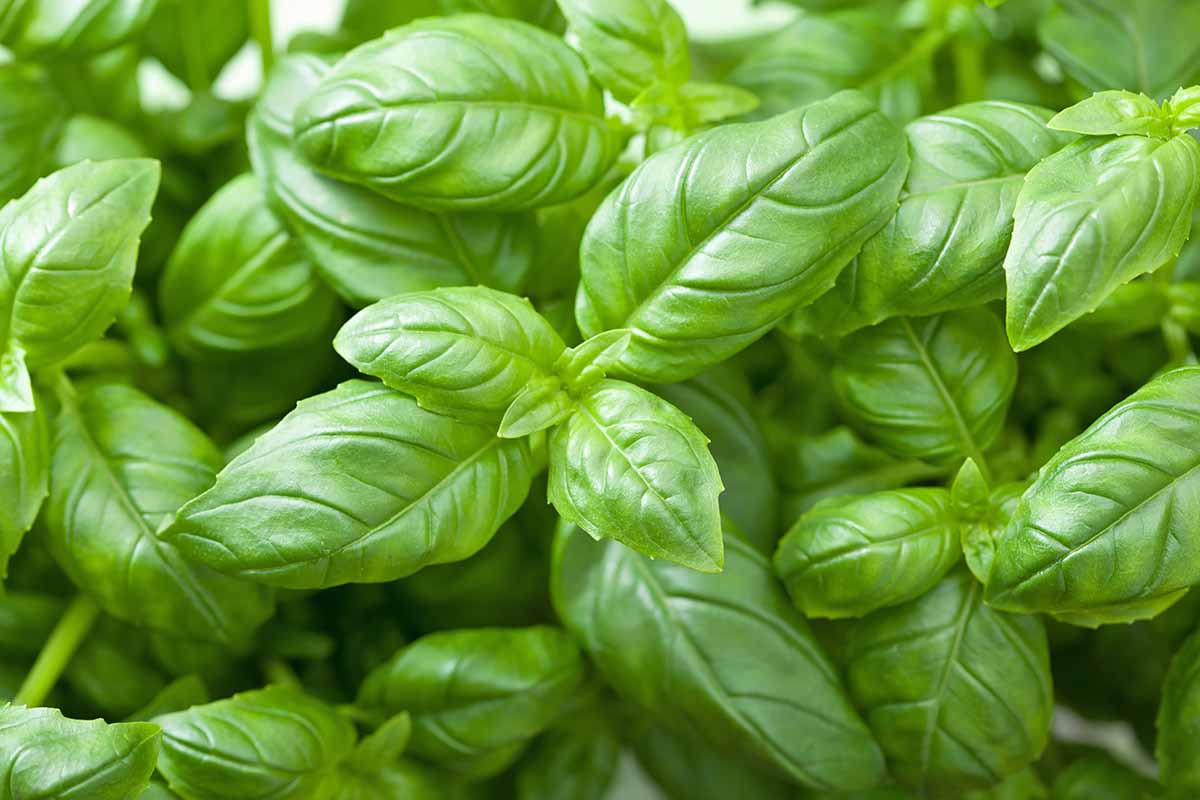
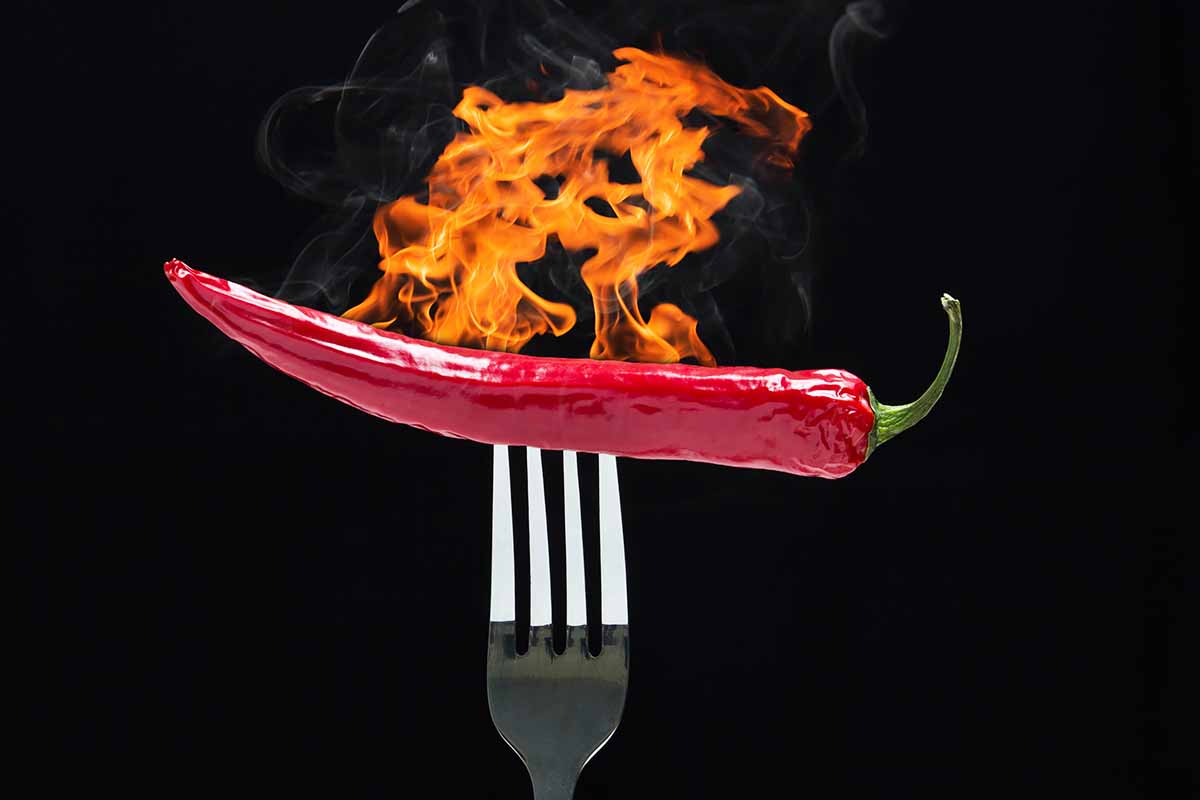
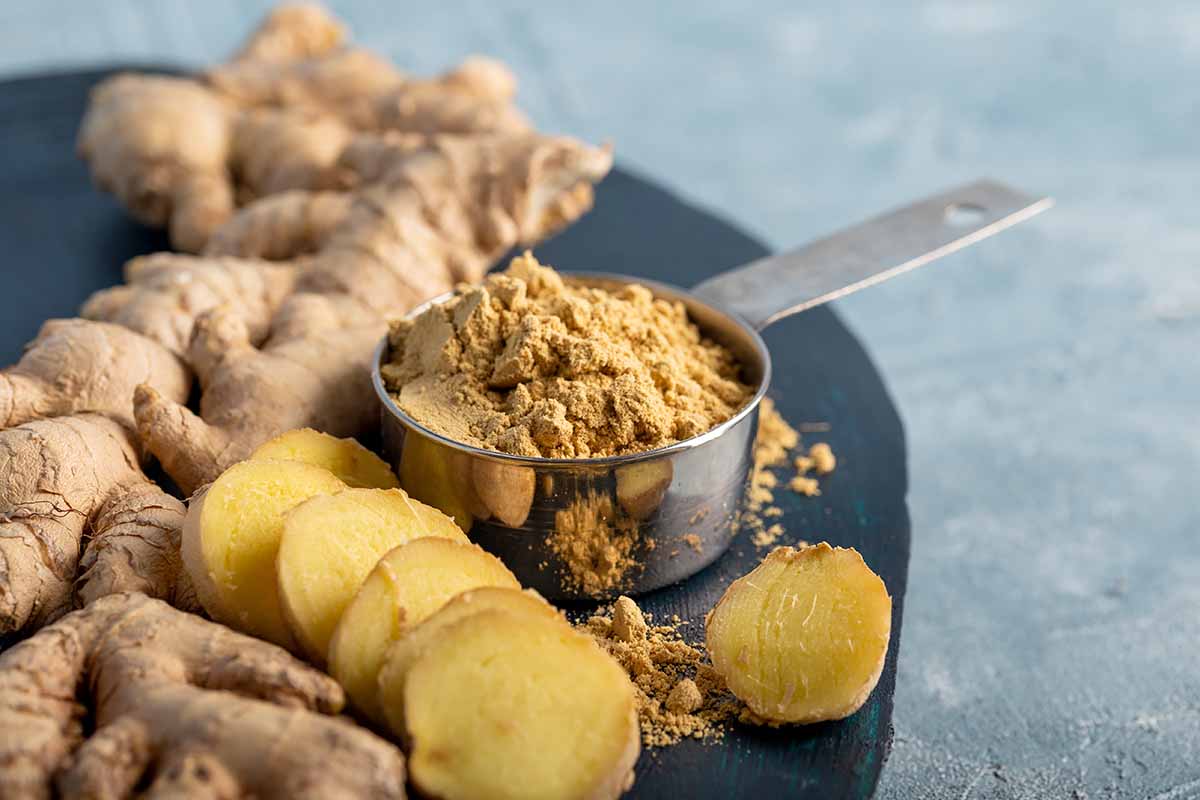
I love love LOVE vanilla ANYTHING. Ice cream, coffee, candy, you name it. If it’s a flavor option, that is most likely going to be my choice. thank you for posting the receipt for the syrup, I definitely will be trying that!
This is really interesting. It provides a lot of information about vanilla. It’s a good, and often healthy additive to foods and drinks. I found the history about where it’s grown, and the details about the synthetic version to be particularly interesting.
I’ve only ever used vanilla extract in making desserts before, and in my opinion it’s good enough. The actual vanilla pods are so expensive, and require delicate handling to release all their flavors. Such an option comes across as a little too tedious and pricey to me.
You’re right, beans belong to the most expensive kind of products when it comes to vanilla. But extract is a perfect substitution, easy to handle and to dose. Plus, you have a nice stock of vanilla flavor that you can use for quite a long time.
I got extract from the Dominican Republic last year and I cannot stress how amazing it is!
It was pretty cheap, and it tastes so much better then anything I purchased in a store in the USA or Canada.
I have even shelled out $50 for high end vanilla and this was still better.
So if anyone goes on vacation where vanilla is produced, do yourself a favor and get some locally sourced product!
Well, that’s great! If I should ever go there, I’d need to get some, too! I can imagine that it is less pricy, because there are no long and expensive transport routes and you can buy directly from the producer. That is fantastic. Enjoy everything you cook and bake with that Dominican vanilla 🙂
I purchased vanilla from the Dominican Republic this spring. I just opened it and it was very thick, not watery like what I’m used to. Is this normal?
Thanks for your question, Janet! What does the packaging look like? There are a few things that might be going on here. First, products from around the world are grown and processed differently. It sounds like you’ve got a dark vanilla on your hands (rather than a “clear” one), and you’ll notice that the flavor is probably a little different and maybe more intense than what you’re used to. This may also be a paste rather than an extract. Finally, it’s possible that this isn’t the authentic product at all – there are some reports of adulterated products coming out of the DR that are made with things like tonka beans and clove. Does it taste good? Try using half of what your recipe calls for, and see how you like it. Good luck!
Sorry, but Dominican Vanilla is fake. You may love it, but it is made from coal tar or coumarin (google it) neither of which you should be eating.
There is no “cheap” vanilla in this world just as there is no “cheap” gold. Vanilla is a commodity and it has a certain price range that will depend on quality, but it is never cheap.
Sorry but you don’t know what you are talking about. I have visited an organic vanilla farm in the Dominican Republic twice! The vanilla is amazing and every tastes better with Dominican Vanilla. I have only purchased it directly from the farm and never online.
Mmmm! Vanilla is one of my favorite flavors and scents and everything else. Love it.
I didn’t know much of this stuff about it. Thanks for the little lesson. It’s interesting to have a few more facts at hand, especially concerning I like very much and use often.
I didn’t used to think there was a big difference between the imitation and pure extract… ha ha. There IS.
Love it, too! The smell and taste of something that has been infused with it, seems irresistible to me 🙂 I’m happy that you liked the article and could get some insight on the different products.
Vanilla is definitely one of my top 5 favorite ingredients to use when cooking. I really enjoyed this article and learning about where vanilla comes from and the process it goes through to end up in our grocery stores as vanilla extract. I am so excited to try the vanilla syrup! I have never heard of vanilla syrup and I am sure it will be delicious.
Thank you! I agree with you, it’s one of my favorite flavors, too!
I hope you enjoy making the syrup, I like to infuse my coffee drinks with a dash or pour some on my pancakes or mixed fruits for breakfast. It’s delicious!
I’d never heard of vanilla sugar, and if I do find some, maybe that would be good for baking? I’m not a huge fan of vanilla, but I do like it in a sponge cake or in cookies. I always find extract hard to determine, if I need more or less, or whether it makes any difference. Using in a sugar form would be more useful and maybe more effective?
Definitely, vanilla sugar is a wonderful thing to add to your baked goodies. It provides a nice, subtle flavor and the seeds look nice in the dough. I understand the issue with extract. It is still a bit rare to get in grocery stores where I live, so I often work with beans, sugar or powder.
So if you just like a slight touch of vanilla and need sugar for your recipe anyway, I’d recommend the sugar variety. You can still (if you’re not a big fan of the spice), divide the amount of sugar your recipes requires and take, for example, 1/3 vanila sugar and 2/3 regular (or in other relations). I hope I could help you decide.
Artificial vanilla doesn’t even come close to the true flavor of real vanilla. Yes, it’s about ten times more expensive but it is so worth it! I remember the first time I bought vanilla beans. I would often open the cupboard where I stored them just to get a whiff. It was so addicting!
You are right in every way. It really pays off to get natural vanilla insted of the sythentic product. And the smell is just fabolous, I always feel attracted by it, too.
This is an interesting read. I never knew this much about vanilla. I knew it was an expensive extract but didn’t realize it was one of the most. I’ve heard of people making their own extract with vanilla beans and alcohol but it seems like a lot of work.
I think so, too. I’ve not yet tried to make my own extract, instead I like to produce my own vanilla sugar or syrup, as those two are always a great addition for my baked goodies.
Where can you order vanilla beans? I want to make vanilla extract. Thank you much for the great information.
I wonder what my favorite flavor would be if vanilla was not realized. Thanks for the recipes. They even make like vanilla more. I really do not know how to cook but i’ll definitely pass them to my mum who’ll do the rest for me.
I absolutely love using real vanilla in my baking! It feels so luxurious and the little black specks make everything look just a bit fancier 😉 My favourite are the bean pods, but the paste is a little more economical and I find that it gives a good flavor, along with that classic speckled look.
I’ve never thought of using vanilla in savory dishes though. I’m definitely going to give that a try with dinner tonight, it sounds like it would add a really interesting background note to a sauce or glaze.
Great, I’d love to hear what you have prepared and how vanilla suited the meal. It was unusual when I tried it the first time – and one has to say that it doesn’t work for every dish – but I figured out there are really some recipes, vanilla works amazing with.
And, I totally agree with you, I just love the little black dots in my cakes, desserts, yogurt, whatsoever 🙂
I agree with this post wholeheartedly. I am a huge vanilla fan and fresh vanilla beans are my favorite. I actually interchange vanilla and lemon all the time. If I don’t have any vanilla I usually use lemon flavoring. Vanilla beans are expensive and right fully so, by the way I hate using imitation vanilla that is just unacceptable in my book. I tell people just go ahead and spend the extra money it will be worth it in the end. Vanilla flavoring has a very long shelf life as well.
Thank you! Oh yes, lemon is a wonderful flavor, too, isn’t it? I just love the refreshing and fruity note it provides for so many things.
Happy to hear that you’re covinced of the natural flavor, as well, you’re right about it. It really makes a difference!
This post is actually so helpful, I wish I found it sooner! I’ve always been so afraid of real vanilla beans. I was always at a loss at how to use then. (When I first saw a a group of pods, I thought it was rotten green beans…Oh dear.) Do I chop it up? Do I blend it? I had absolutely zero clue that we were supposed to use the seeds and sometimes the whole pod to infuse the flavor with.
I also had no idea it came in so many variants! I’m definitely interested in getting some powder, it seems like the perfect alternative for someone lazy like me.
Also, thank you for the recipe! I’ve been collecting syrup recipes to use in my bubble tea mixes, and a vanilla tea with boba sounds pretty delicious to me!
Thank you! How great that you now have some ideas how to use and work with the black pods 🙂 It’s also nice to have some other vanilla products around for different kinds of recipes, just take a look and see what might work best for your needs. Enjoy the syrup and the wonderful flavor!
Nice historic trip, learned a lot about vanilla and its origin! I would probably not eat as many sweet desserts as I do right now. I replace chocolate with vanilla in a lot of cakes and dishes, such as Choux a la Creme or cakes. It tastes much better.
Thank you. I think it works great to replace those two flavors. Although I’m a big fan of chocolate, too, I love a simple recipe that is flavors with warm vanilla. It just doesn’t need much more, right? 🙂
The recipe would be great in iced coffee right now, since it’s so hot. It’s my favorite flavor for hot coffee as well, but iced sounds really good right now.
I still haven’t tried it in anything savory, but I’m willing to give it a go. I know some people like sweet cornbread, so that could work.
I think it would also be good in a raspberry vinaigrette (but only the pure stuff, of course).
Absolutely! I simply love coffee drinks with some vanilla note! A vinaigrette is a perfect way to try it out, as it has both sweet and sour notes, so it’s kind of safe to try 😉
Well I always find it fascinating to learn about things that I use all the time, but never really think about in that sort of way. There is a lot more to vanilla than just the little bottle in the drawer, so thanks for sharing this. I did not know what certain areas produce it for particular reasons, but I guess that makes sense. I know I love the smell and I know it comes in handy when I am baking, so I am glad that all these areas can produce it. Thanks again for sharing.
Someone gave me some white vanilla from the DR. The brand is Vera Cruz. It is very thick, mild in flavour and almost smells like it has a hint of cinnamon. Anyone have any thoughts or knowledge about this product?